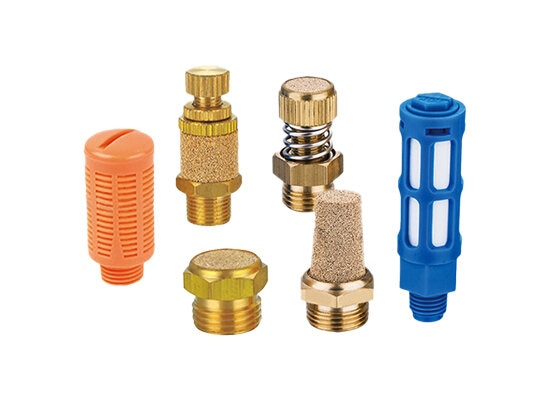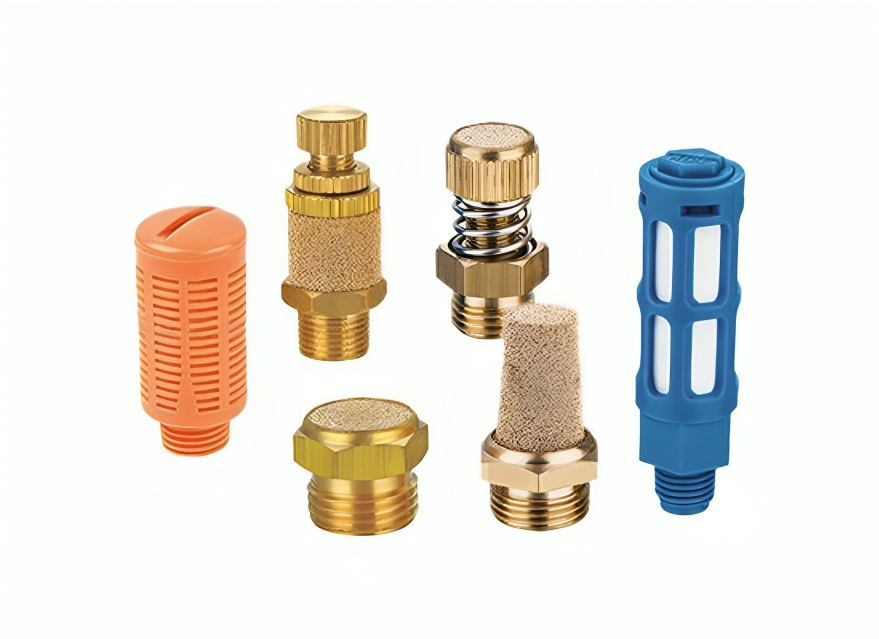- sales@fokca.com info@fokca.com
- WhatsApp: +86 150 5749 1870

What is a pneumatic muffler
Pneumatic exhaust silencers serve as critical acoustic control components in compressed air systems, employing multi-stage noise reduction technology to attenuate exhaust energy efficiently. Engineered specifically for pneumatic valve manifolds, actuators, distribution blocks and auxiliary equipment, these devices utilize optimized silencing architectures to deliver superior noise suppression across 100-8000Hz frequency spectrums, complying with OSHA/ISO industrial noise emission standards.
This is the navigation bar for the following article:

Hybrid Silencing Mechanism: Integrates dissipative and reactive silencing principles to dual-filter high-frequency pulse noise and low-frequency aerodynamic howl
Computational Fluid Dynamics: Internally optimized flow paths via CFD simulations achieve 25-38dB(A) sound pressure level reduction while maintaining exhaust efficiency
Environmental Durability: All-metal high-temperature construction (operating range -40℃~350℃) with anodized surface treatment enhancing corrosion resistance by 300%
Modular Configuration: Offers threaded/flanged dual-interface options supporting ISO 6150 quick-mount standards
Certified through accredited acoustic performance testing, these silencers maintain linear attenuation characteristics under 5bar working pressures,
effectively mitigating transient noise exceeding 120dB during compressed air release.
This provides industrial automation environments with NIOSH-compliant occupational health acoustic solutions.
In fluid dynamics, pneumatic noise generation can be attributed to the unsteady dynamic behavior of turbulent shear layers.
When high-velocity turbulent airflow is discharged through exhaust ports into a relatively stationary ambient medium, intense vortex shedding occurs,
with the unsteady motion of fluid parcels constituting the primary acoustic source. According to Lighthill's acoustic analogy,
this process can be decomposed into four noise-generating mechanisms:
Turbulent Mixing Noise: Arises from momentum exchange between exhaust jets and surrounding air,
with sound power spectral density positively correlated to turbulence intensity,
particularly pronounced in transonic flows
Velocity Blockage Effect: Reduction in effective flow area through finite-sized orifices increases flow velocity,
creating secondary noise sources whose sound pressure levels scale with the sixth power of velocity (~V⁶)
Boundary Layer Instability: Transition and separation of wall-bounded layers in exhaust ducts excite broadband noise,
with frequency characteristics dependent on boundary layer thickness and Reynolds number
Pressure Pulsation Coupling: At high-pressure ratios (>25 psi), system pressure fluctuations modulate noise spectra,
though above critical pressures, simple pressure reduction yields diminishing marginal noise suppression benefits
Notably, when system operating pressures exceed the 2 bar threshold, while absolute sound power continues to rise with pressure,
noise control should prioritize silencer configuration optimization over pressure reduction alone. According to ISO 11201 acoustic testing standards,
properly configured multi-chamber reactive silencers can reduce exhaust noise by 15-28 dB(A) in typical industrial applications while maintaining system energy efficiency.
Pneumatic Exhaust Silencers, as critical components in noise control engineering,
achieve high-efficiency noise reduction through optimized flow path design and porous acoustic media.
These devices are directly integrated at the exhaust port, employing patented diffuser structures to disperse high-velocity airflow across large-surface acoustic materials,
effectively reducing flow velocity (ΔV≥50%) and suppressing turbulence fluctuations (Re number reduction ~40%), yielding broadband noise reduction of 15-35 dB(A).
Significantly, each 10 dB(A) reduction corresponds to 50% acoustic energy attenuation, marking a pivotal improvement in workplace acoustic quality.
Contemporary air compressor muffler technology offers diversified material solutions:
Polymer-Matrix Composite Silencers: Precision injection-molded with nano-scale plastic fiber felts or metal powder sinters.
Advantages include lightweight construction (40-60% lighter than metal counterparts), superior chemical resistance,
and excellent absorption coefficients across 200-8000Hz.
Specialized formulations enable stable operation from -45℃ to +120℃.
Brass Alloy Silencers: CNC-machined from copper-based substrates, filled with sintered bronze particles or metal wool.
Distinguished by exceptional thermal conductivity (>200W/m·K) and 300°F continuous operating capability, suitable for high-temperature oil-mist environments.
Acoustic performance is optimized via Helmholtz resonators for effective low-frequency noise (<500Hz) suppression.
Stainless Steel Silencers: Constructed from 316L medical-grade stainless steel with integrated metal mesh matrices or powder metallurgy bodies.
Engineered for harsh conditions, withstands 400°F temperatures and high-pressure water jetting,
with surface passivation layers providing outstanding corrosion resistance (>500h salt spray test).
Gradient porosity structures deliver broadband absorption characteristics, particularly suited for sterile processes in pharmaceutical and food industries.
Material selection requires comprehensive consideration of media properties, temperature ranges, and budgetary constraints.
Air compressor exhaust silencers typically incur 30-50% higher initial costs than air compressor intake mufflers due to material and processing complexities,
but demonstrate superior life-cycle economics. Plastic silencers offer exceptional value in conventional applications,
though caution is advised to avoid thermal degradation at elevated temperatures.
When choosing a pneumatic muffler, we should consider the size range from less than 0.125 inches (3 millimeters) to greater than 2 inches (50 millimeters).
They should comply with the manufacturer's specifications for allowable pressure range and connector size and type.
The most important consideration when installing a pneumatic muffler is the impact of the equipment on the airflow.
Any significant limitation will reduce the working capacity of the compressed air circuit due to back pressure caused by small size or pollutant blockage.
Therefore, the correct selection and maintenance are crucial. If the application is particularly sensitive to back pressure, please choose a device with additional flow capacity.
The cleanliness of compressed air is a critical factor affecting backpressure and noise reduction. Therefore, appropriate filtration is essential.
Additionally, the porosity and surface area of diffusion materials vary across different products.
Small apertures can provide compact and effective mufflers with reasonable airflow rates.
However, in air pipelines contaminated by pollutants, silencers can quickly become restricted and interfere with the operational capabilities of the machinery they are installed on,
thus necessitating materials with larger apertures.
Silencers can also integrate multiple functions into a single component to streamline operations and conserve space.
For instance, they may incorporate adjustable throttle valves to control the airflow rate exiting the equipment.
The muffler may also house a filter to eliminate oil mist and dust from the exhaust gas prior to its release into the surrounding environment.
If you have any additional questions, You can get more information here:https://www.fescolo.com/pneumatic-muffler/
Links: www.fescolo.com(Pneumatic)
FOKCA ©1998-2025 All Rights Reserved Sitemap